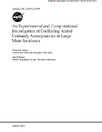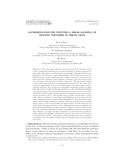Evaluation of Turbulence Models for Unsteady Flows of an Oscillating Airfoil
| dc.contributor.author | Srinivasan, G.R. | |
| dc.contributor.author | Ekaterinaris, J.A. | |
| dc.contributor.author | McCroskey, W.J. | |
| dc.date | Jan 01, 1995 | en_US |
| dc.date.accessioned | 2018-09-27T00:07:06Z | |
| dc.date.available | 2018-09-27T00:07:06Z | |
| dc.date.issued | 1995-01 | |
| dc.identifier.citation | Computers and Fluids; p. 833-861; (ISSN 0045-7930); Volume 24; No. 7 | en_US |
| dc.identifier.other | 19970003710 | |
| dc.identifier.other | NASA-TM-111942, NAS 1.15:111942 | |
| dc.identifier.uri | https://hdl.handle.net/10945/60147 | |
| dc.identifier.uri | https://ntrs.nasa.gov/search.jsp?R=19970003710 | |
| dc.description | The article of record as published may be found at http://dx.doi.org/10.1016/0045-7930(95)00016-6 | en_US |
| dc.description.abstract | Unsteady flowfields of a two-dimensional oscillating airfoil are calculated using an implicit, finite-difference, Navier Stokes numerical scheme. Five widely used turbulence models are used with the numerical scheme to assess the accuracy and suitability of the models for simulating the retreating blade stall of helicopter rotor in forward flight. Three unsteady flow conditions corresponding to an essentially attached flow, light-stall, and deep-stall cases of an oscillating NACA 0015 wing experiment were chosen as test cases for computations. Results of unsteady airloads hysteresis curves, harmonics of unsteady pressures, and instantaneous flowfield patterns are presented. Some effects of grid density, time-step size, and numerical dissipation on the unsteady solutions relevant to the evaluation of turbulence models are examined. Comparison of unsteady airloads with experimental data show that all models tested are deficient in some sense and no single model predicts airloads consistently and in agreement with experiment for the three flow regimes. The chief findings are that the simple algebraic model based on the renormalization group theory (RNG) offers some improvement over the Baldwin Lomax model in all flow regimes with nearly same computational cost. The one-equation models provide significant improvement over the algebraic and the half-equation models but have their own limitations. The Baldwin-Barth model overpredicts separation and underpredicts reattachment. In contrast, the Spalart-Allmaras model underpredicts separation and overpredicts reattachment. | en_US |
| dc.rights | This publication is a work of the U.S. Government as defined in Title 17, United States Code, Section 101. Copyright protection is not available for this work in the United States. | en_US |
| dc.title | Evaluation of Turbulence Models for Unsteady Flows of an Oscillating Airfoil | en_US |
| dc.type | Reprint | |
| dc.contributor.corporate | Ames Research Center | |
| dc.subject.author | TURBULENCE MODELS | en_US |
| dc.subject.author | UNSTEADY FLOW | en_US |
| dc.subject.author | FLOW DISTRIBUTION | en_US |
| dc.subject.author | FINITE DIFFERENCE THEORY | en_US |
| dc.subject.author | NAVIER-STOKES EQUATION | en_US |
| dc.subject.author | COMPUTATIONAL FLUID DYNAMICS | en_US |
| dc.subject.author | AIRFOILS | en_US |
| dc.subject.author | OSCILLATIONS | en_US |
| dc.subject.author | SEPARATED FLOW | en_US |
| dc.subject.author | AERODYNAMIC STALLING | en_US |
| dc.subject.author | TWO DIMENSIONAL MODELS | en_US |
| dc.subject.author | HORIZONTAL FLIGHT | en_US |
| dc.subject.author | HARMONICS | en_US |
| dc.subject.author | PRESSURE DISTRIBUTION | en_US |
| dc.subject.author | RENORMALIZATION GROUP METHODS | en_US |
| dc.subject.author | ROTARY WINGS | en_US |
| dc.subject.author | REYNOLDS EQUATION | en_US |
| dc.subject.author | HYSTERESIS | en_US |
| dc.description.funder | DAAL03-90-C-0013 | |
| dc.description.distributionstatement | Approved for public release; distribution is unlimited. |





